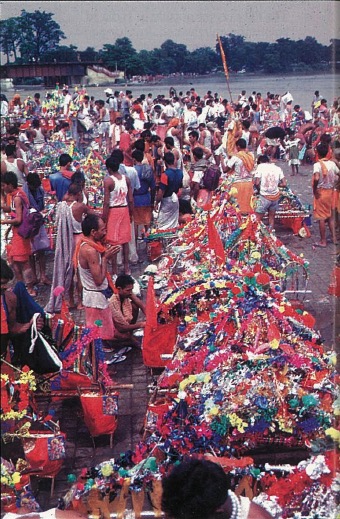By RAJIV MALIK, NEW DELHI
In Delhi I am used to a very comfortable lifestyle,” said Delhi businessman Navin Yadav, “but after walking forty kilometers in a day, I had no problem sleeping on the floor or in any open space. It is indeed a very powerful experience. My feet were so full of blisters, but God gave me the strength to carry on the journey.”
Yadav was one of 1.5 million kanwaria pilgrims who trekked to Neelkanth, near Haridwar, to fetch sacred water from the Ganga and take it back to their home place. They traveled all or part way on foot and took but one meal a day. It was the largest number of pilgrims to date for this yearly observance. Many journey hundreds of kilometers to and from their villages throughout Uttar Pradesh and neighboring states. Others, like Yadav, make the arduous trek on foot from Delhi itself.
Their name comes from the pole each carries known as a kanwar. It has a pot on either end to hold the Ganga river water. The 210-km (126-mile) trip from Neelkanth back to Delhi takes six days on foot. Kanwarias don’t undertake this journey for penance, explains one. “They carry it for two reasons–to thank God for fulfilling one’s wish, or to tell Him to let things stay as they are. Kanwarias are mostly satisfied people.”
The journey is not without its dangers, however, and each year a few kanwarias are injured or killed in road accidents. Short of such major problems, it is rare that one drops out half way. Satish Kumar, age 32, recounts, “My first journey a couple of years back was very inconvenient, I had body aches and wounds. This time it was much better for me, but some of my companions underwent a lot of suffering.”
Echoing the concerns of other kanwarias, Kumar said, “We have heard that in the past Muslims used to physically intimidate Hindus, but things are improving now. There are good Muslims who take you to their houses, try to make you comfortable and offer eatables.”
The people of Delhi are much uplifted by the passing through of the kanwarias, which is like watching an endless series of wedding processions. Previous years’ pilgrimages have caused traffic jams, but special arrangements this year ensured a smooth interaction of traffic and pilgrims.
The city government of Delhi set up hundreds of camps during June and July to shelter and feed the hundreds of thousands of kanwarias passing through the city. Local religious organizations also organized assistance. At these places pilgrims could spend the night on a carpet, wash and feed themselves and, as necessary, bandage their worn feet. At the roadside camp in Paschim Vihar, West Delhi, I saw the young kanwarias dancing and merrymaking to the beat of drums, despite sore feet and shoulders. In fact, there was hardly any sign of physical fatigue. In keeping with tradition, this group offered a portion of their Ganga water to the Siva Lingam at a nearby Siva temple.
